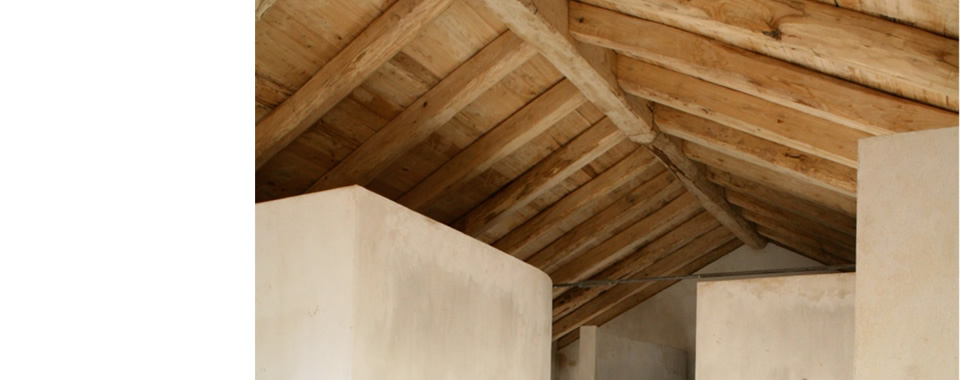

Score - Sustainable Construction in Rural and Fragile Areas for Energy efficiency
Guidelines for Integrated territorial Planning:
Involucre (insulation, mass, PCM)
The following guidelines come from a deep analysis of case studies, norms and regulations, in relation to the both national and regional level. This analysis is summarized in a card that can be downloaded in Spanish language.
Up to 70% of the total energy consumption in buildings can be attributed inner space conditioning. The use of renewable production, more efficient equipment, and personal habit change are options currently available to increase awareness about energetic waste. A rating system to distinguish between buildings in accordance to their energetic efficiency was established in Spain under the Royal Decree 47/2007 (Basic Procedure for Energetic Certification in New Buildings). The objective of energetic independence of buildings can be reached by improving the way they work on a number of levels, from the upgrading of materials, to improved constructive solutions, and most importantly thermal isolation. On site supervision of construction standards, followed by final performance inspections will further assist with ensuring the guidelines for energetic independence are employed.
The improvement of building enclosure has evident benefits on electricity efficiency. This consequently leads to minimizing the impact on the environment through lower production needs and therefore lower CO2 emissions. Opportunities to monitor the energetic costs during production and the setting up stage of the materials involved in every constructive solution must also exist in order to have an overall view of the real energetic balance within the construction industry. This will lead to the appearance of the concept of "energetic or ecological cost".
Almost all of the alternatives for wrapping of buildings in Mediterranean rural areas are designed as passive strategies of environmental conditioning, as they do not depend on any electricity or other energetic source consumption. These solutions can be implemented in all kind of constructions, independently of the use, as this design concept can easily be adapted to suit. This versatility can be extended, in a higher or lower level, and even in historic contexts, as any passive solution will always assist in improving existing conditions.
Research in new materials and constructive solutions is one of the main development fields in the building industry, which is necessary for the evolution and the continuous improvement of this sector. In addition, a wider catalogue of products could be developed, increasing the possibilities for architectonic creativity and different options for enclosing. Nowadays a high variety of elements and technologies can be acquired in the national market, as there is a large network of specialized companies. This trade network is connected as well, thanks to the global information systems, with the main international manufactures.
Although a flexible and dynamic industry, and despite the current change of the global mind in relation with the ecological threats, reticence for conventional schemes renovation can still be found in this sector. These difficulties are often based in unfounded believing, such as less quality of new materials, maintenance issues or higher costs.
The legal and regulatory frame is already extensively developed in relation with the closure energy efficiency, especially in the national level (see annex 1 of the card). Although, we can find some incongruence between different current laws, which differ depending on the subject they tackle (for example in ventilation conditions, permanently opened air slots are demanded in residence buildings).
The Spanish laws also leave the technicians with an overall responsibility for assuming tasks at every level of the project (designing and calculating of every constructive solution, checking of the requirements of all the materials on site, controlling of the built construction). There are no references about the necessary tests for assuring the correct performance of this law, and no involvement of independent entities is demanded. This means that, many times, these tests are missed so there`s no way to check out the suitability of the different solutions, avoiding the opportunity to have a feedback of the process.
The diffusion of sustainable works with building enclosure improvement could be facilitated following some advices such as:
- Fostering research programs for new materials and technologies development, as a way to ease innovation in the construction industry.
- Creation of forum with the aim to spread these progresses, in a national level at least.
Pursuant to the guidelines written above, here are synthetically reported the criteria/examples for pilot projects to be financed in MED territory, in relation with the specific treated theme.
These criteria/examples, together with the ones resulting from all the themes of eco-construction tool matrix, will make up a Bio-construction Action Plan for each partner countries.
- Research projects for new materials and solutions, and forum creation for spreading the different progresses.
- Design of projects for the implementation of an energy labeling system for construction products and materials, with the objective of defining the balance between wasted and saved energy in the whole process.
- Normative and regulations adjustment for establishing control systems for built constructions, with the aim of assuring the proper implementaton of the law. This is the only way of detecting dysfunctions to feedback the continuous improvement process.
The current Spanish certification system for new buildings enclosure is defined in the Royal Decree 47/2007. These rules also consider aspects such as façade facing, external environment conditions, passive or protection solar systems, thermal conditioning systems, natural ventilation, etc. Despite of this, some other important inputs are missed (energy expense during production and setting up stages, recycled materials, etc). It isn’t considered necessary that green building certifications should be made more complicated. However we think it would be recommended to include these other aspects for a broader view of the energetic efficiency problem.
Case studies
- Passive House in Dionisi. Cogoleto (GE).
- House in Mallorca (Palma de Mallorca)
